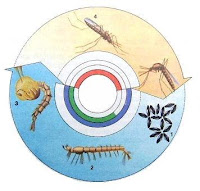Mosquitoes can be distinguished from other true flies by an elongated sucking proboscis and scales along the wing veins and on the body. The scales vary in color and arrangement, giving each species a characteristic appearance. The species belong to the insect order Diptera, family Culicidae. The more than 2600 species are divided into 31 or more genera, 12 of which are found in the

Only female are blood feeders, although both males and females feed on flower nectar. Most females require a blood meal to produce a batch of eggs. A mosquito may be attracted to its victim by warmth, odor, moisture and even carbon dioxide. Using carbon dioxide gradients, the mosquito may be able to follow a sleeping person's breath to its source.
The mosquito's mouthparts consist of two pairs of needlelike maxillae and mandibles; a food channel, which sucks up the blood or nectar, a saliva channel, and a sheath. When a mosquito bites, it first inserts the pointed, barbed pair of maxilae, which achor the mouthparts in the skin and provide leverage for the insertion of the remaining four parts. The sheath slides back as the other mouthparts pass through its tip. The mosquito's saliva, which contains anticoagulants to stop the blood from clotting, is injected into the skin, causing the area around the bite to swell and itch.
Mosquito control is effected in several ways, including draining breeding areas. Applying thin oil to water to kill the larvae, spraying with insecticides, and employing biological agents, such as small fishes that eat mosquito larvae. The incidence of mosquito-borne disease, however, is increasing rapidly. The tiger mosquito, Aedes albopicus, unlike other mosquitoes, is able to carry many disease-causing viruses. Native to Asia, it is now also found in
Many kind of mosquito can transfer diseases to human, usually diseases that caused by virus. Many diseases can be transferred by mosquito like dengue fever, malaria, westnile diseases, cikungunya as in Indonesia and many others.
No comments:
Post a Comment
Write your commend here, you can create back link here.